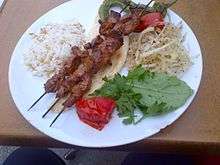Shish kebab

Shish kebab (Turkish: şiş kebap; Persian/Mazandarani: شیش کباب, šiš kabāb) is a popular meal of skewered and grilled cubes of meat.[1] It is similar to or synonymous with a dish called shashlik, which is found in the Caucasus region.[2]
It is one of the many types of kebab, a range of meat dishes originating in the Middle East. In English, the word kebab alone often refers to shish kebab, though outside of North America, kebab may also mean doner kebab.
It is traditionally made of lamb (kuzu şiş)[3] but there are also versions with beef or veal (dana şiş), swordfish (kılıç şiş)[4] and chicken meat (tavuk şiş or şiş tavuk). In Turkey, shish kebab and the vegetables served with it are grilled separately, normally not on the same skewer.[5]
Etymology
Shish kebab is an English rendering of Turkish: şiş (sword or skewer) and Turkish: kebap (roasted meat dish).[6][7] The earliest literary evidence for the Turkish word şiş as a food utensil comes from the 11th-century Diwan Lughat al-Turk, attributed to Mahmud of Kashgar. He defines shish as both a skewer and 'tool for arranging noodles' (minzam tutmaj), though he is unique in this regard as all subsequent known historical references to shish define it as a skewer.[8][9]
The Turkish word kebap is derived from the Arabic word kabāb, meaning roasted meat. It appears in Turkish texts as early as the 14th century, in Kyssa-i Yusuf (the story of Joseph), though still in the Arabic form. Etymologist Sevan Nişanyan states that the word has the equivalent meaning of "frying/burning" with "kabābu" in the old Akkadian language, and "kbabā/כבבא" in Aramaic.[10] The word kebab came to English in the late 17th century, from the Arabic: كَبَاب (kabāb), partly through Urdu, Persian and Turkish.[11]
The term 'shish kebab' had its first literary publication in English in 1914 in the novel Our Mr. Wrenn by Sinclair Lewis.[6][12]
See also
References
| Look up shish in Wiktionary, the free dictionary. |
| Wikimedia Commons has media related to Şiş kebap. |
- ↑ John Ayto (18 October 2012). The Diner's Dictionary: Word Origins of Food and Drink. OUP Oxford. pp. 192–. ISBN 978-0-19-964024-9.
- ↑ Davidson, Allen, "The Oxford Companion to Food", p.442.
- ↑ Ozcan Ozan (13 December 2013). The Sultan's Kitchen: A Turkish Cookbook. Tuttle Publishing. pp. 146–. ISBN 978-1-4629-0639-0.
- ↑ Mimi Sheraton (13 January 2015). 1,000 Foods To Eat Before You Die: A Food Lover's Life List. Workman Publishing Company. pp. 1090–. ISBN 978-0-7611-8306-8.
- ↑ Steven Raichlen (28 May 2008). The Barbecue! Bible 10th Anniversary Edition. Workman Publishing Company. pp. 214–. ISBN 978-0-7611-5957-5.
- 1 2 "shish kebab". Oxford English Dictionary (2nd ed.). Oxford University Press. 1989.
- ↑ Marks, Gil (17 November 2010). Encyclopedia of Jewish Food. HMH. ISBN 9780544186316 – via Google Books.
- ↑ "The Horseback Kitchen of Central Asia". Food on the Move. Oxford Symposium on Food and Cookery. 1996. Retrieved 2018-07-16.
- ↑ "Nişanyan Sözlük - şiş" [Nişanyan Dictionary - shish]. Nişanyan Sözlük (in Turkish). Retrieved 2018-07-16.
- ↑ Nişanyan Sevan, Sözlerin Soyağacı, Çağdaş Türkçenin Etimolojik Sözlüğü, Online, Book
- ↑ "kebab - definition of kebab in English". Oxford Dictionaries. Oxford University Press. Retrieved August 3, 2017.
- ↑ Lewis, Sinclair (11 March 2015). Our Mr. Wrenn - The Romantic Adventures of a Gentle Man. Read Books Ltd. ISBN 9781473372498 – via Google Books.